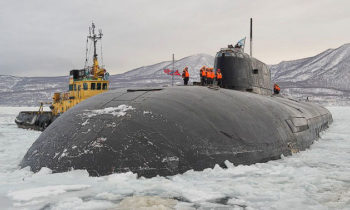 Russian naval presence in the North Atlantic and High North areas is beginning to bring about the revisited notion of collective defence in the maritime domain, according to Norwegian State Secretary for Defense Oystein Bø.
Russian naval presence in the North Atlantic and High North areas is beginning to bring about the revisited notion of collective defence in the maritime domain, according to Norwegian State Secretary for Defense Oystein Bø.
Speaking at UDT 2016 in Oslo, where he delivered the inaugural speech for the event, Bø said that Russia had shown itself to have new maritime capabilities and had increased its presence in the High North waters.
‘Russian armed forces are training more often and of an increasingly complex nature, and is occurring without advanced notification. This is a revisitation of the bastion concept [used by the Soviet Navy during the Cold War],’ he said.
‘[Russia] has an increase in its ability to conduct anti-access area denial in the North Atlantic and add to this the allied presence in the High North has been gradually reduced.’
Bø was at pains to say that Norway did not consider Russia a military threat, but that it was in the interest of all Arctic states that the area remained stable.
‘We would like to see a more frequent allied presence in the High North and North Atlantic and to invest in maritime capabilities to ensure it remains politically and militarily credible.’
Bø added that Norway is in the final stages of concluding a new long-term plan of action for its Armed Forces, key among those was the need to replace the P-3 Orion maritime patrol aircraft (MPA), the procurement of a new fleet of submarines to replace the ageing Ula-class, investment in ISR capabilities and to remain committed to the F35 Joint Strike Fighter.
The Norwegian Defence White Paper is due on 17 June, which will outline procurement plans through the 2020s and 2030s. Bø said that they would strive towards meeting the 2% military spending target that all NATO members aimed for, but did caution that it was as important to ensure that what was spent was done so wisely.
On the Norwegian defence industry, Bø stated that while small, there had been some notable successes, as seen with its work in unmanned technology, missile systems and remote operator stations produced by indigenous companies.
Submarines meanwhile remained a leading influencer on the seascape, thanks to the ability to conduct surveillance and covert operations, but acknowledged the increasing cost per unit of modern platforms needed to be taken into account.
‘We have to get more bang for our buck… new technology is driving more efficient operational solutions [and] the tasks are increasingly more challenging.’
In the morning session on 1 June, a senior military officer present said that hybrid military operations, similar to those witnessed in Ukraine, were also beginning to be seen in the underwater domain. This activity served to highlight some of the challenges facing navies in a changing seascape, he said.
A representative from an industry company meanwhile said that platforms were getting more expensive and larger, particularly in the undersea domain. In an effort to extract the maximum value from its own submarine fleet, Germany would test the notion of mustering two crews for one vessel in order to enable its continuous use over the next two years.
Manpower was also a hot topic during the opening morning of the event, as defence officials spoke of the difficulties in ensuring crews remained motivated during long absences at sea and the need to avoid a boom and bust cycle of platform readiness.
(UDT)
